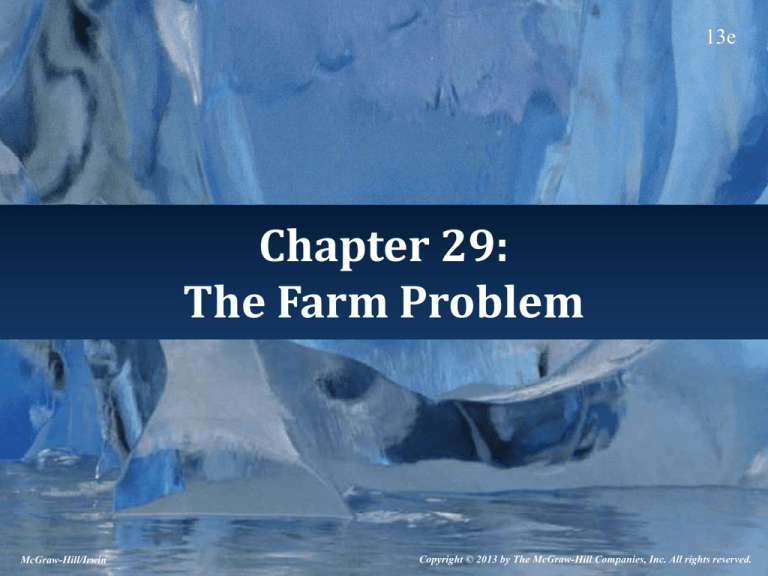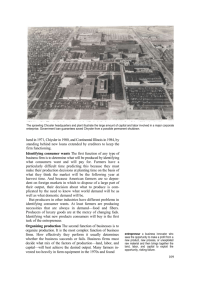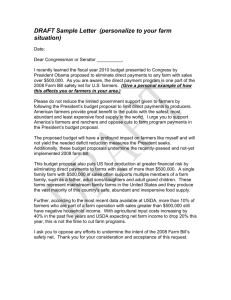
13e
Chapter 29:
The Farm Problem
McGraw-Hill/Irwin
Copyright © 2013 by The McGraw-Hill Companies, Inc. All rights reserved.
U.S. Agriculture
• Should American farmers participate in a
free market?
– No federal subsidies?
– Produce what you want and how much?
– How much farmland to use or leave fallow?
• Or …
29-2
U.S. Agriculture
• Should the government dictate what, how, and
how much product American farmers should
produce?
– Restrictions on what you can grow and how much?
– Price guarantees?
– Income guarantees?
• The Farm Act of 2008 generated subsidies to
many more farmers, and “free-market”
agriculture seemed to disappear.
29-3
Learning Outcomes
• 29-01. Know what makes the farm business
different from others.
• 29-02. Know some mechanisms used to
prop up farm prices and incomes.
• 29-03. Know how farm subsidies affect farm
prices, output, and incomes.
29-4
Destabilizing Forces
• The agriculture industry is one of the most
competitive in America.
– Individual farmers have no market power.
– There are low barriers to entry.
– When there are economic profits, farm production
expands and new farmers enter the industry.
• Individual farmers behave like perfect
competitors.
– They produce an output corresponding to MC = p.
29-5
Destabilizing Forces
• Technological advance.
– There has been a spectacular technological
advancement in agriculture.
• Production has increased enormously.
• Productivity has increased even faster.
– Thus the supply curve for agricultural products
has shifted radically to the right, causing farm
prices to fall.
29-6
Destabilizing Forces
• Inelastic demand.
– There is an upper limit to the amount of food
people want to eat.
– When farm prices fall, consumers do not
increase their food purchases much.
– Added production actually yields lower
revenues.
– A bumper crop would drop prices so much that
farmers actually earn less than in a normal
production year.
29-7
Destabilizing Forces
• Income elasticity.
– As consumers’ incomes rise, they do not
significantly increase their consumption of food.
– They may alter the types of food purchased, but
not the amount by much.
• The increasing quantity of food produced in
the United States must be reconciled with
very slow growth of U.S. demand for food.
29-8
Destabilizing Forces
• Abrupt shifts in supply.
– There are abrupt shortterm swings in
production.
• Good weather: abundant
harvests.
• Bad weather or natural
disaster: scant harvests.
– In either case, farm
income falls.
29-9
Destabilizing Forces
• Response lags.
– The production decision for farmers occurs
before the beginning of the planting season.
– The results of that production come at harvest,
after all natural influences on growing have
occurred.
• High prices last year? Plant more this year.
• All farmers do this independently, so more crop
reaches the market, and the price plunges.
29-10
U.S. Farm Policy
• Congress has responded to agricultural
problems with a variety of programs designed
to raise or stabilize farm products’ prices.
• These include
–
–
–
–
–
Price supports.
Supply restrictions.
Demand distortions.
Cost subsidies.
Direct income support.
29-11
Price Supports
• Congress sets a minimum price (above
market equilibrium) that a farm good can
sell for.
– This encourages producers to grow more.
– This encourages buyers to purchase less.
– A market surplus is created.
– Since the price cannot fall, the surplus must be
disposed of some other way.
• Usually government buys up the surplus and
stockpiles it.
29-12
Supply Restrictions
• Congress attempts to reduce production by
paying farmers to reduce the acreage under
plow. These are acreage set-asides.
– Similarly, farmers could be paid to reduce herds.
• Marketing order laws can restrict quantities of
output brought to market. Any excess must be
destroyed by the farmer.
• Import quotas can also restrict supply by
limiting the amount foreigners supply to the
American market.
29-13
Demand Distortions
• Government can lend money to farmers at a
set rate for each unit of production.
• If the price of that good rises above the loan
rate, the farmer can sell the good and repay
the loan, keeping the difference.
• If the price stays below the loan rate, the
government buys the surplus crops.
29-14
Cost Subsidies
• Government can subsidize the input costs to
farmers.
– They subsidize water use, fertilizer, drainage,
and other costs.
– Government also funds research, insurance,
marketing, grading, and inspection services for
farmers.
29-15
Direct Income Support
• The goal of most of these programs is to
boost the farmers’ income.
• By switching to direct income supports,
Congress can reduce the market distortions
induced by other programs.
– If a crop’s price falls below the target price, the
government makes up the difference.
29-16







